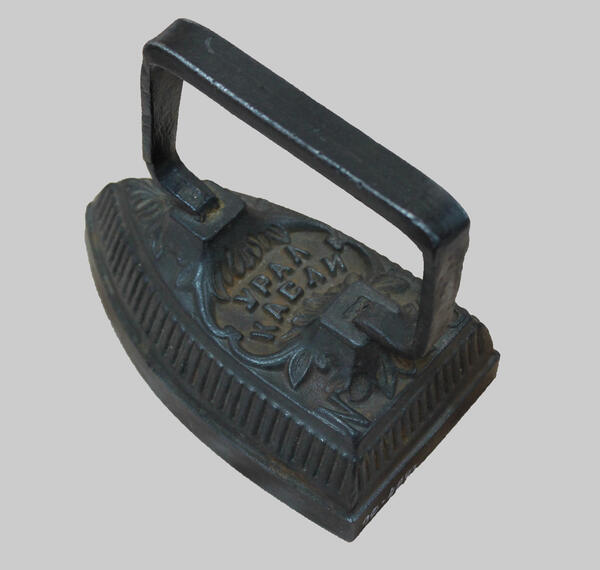The cast iron from the museum’s collection has a smooth sole and a non-removable handle. The sides of the device are decorated with ornaments. The inscription “URAL KASLI No. 3” on the top of the iron indicates that it was made by one of the workers of the Kuibyshev artel in the city of Kasli, Chelyabinsk Region.
Cast-iron irons appeared in the 18th century. These irons did not have an internal heat source. They were heated in a furnace or on an open fire. Large cast-iron irons weighed up to ten kilograms and were intended for ironing coarse fabrics. To iron fine fabrics and small details of clothing, such as cuffs or collars, they used small irons with the size of half a palm.
The cast-iron iron was heated for a very long time for at least half an hour. At the same time, it quickly cooled down, and the clothes had to be ironed in a hurry. The metal handle of the monolithic iron was so hot that it was impossible to hold this device without a potholder.
Despite all the disadvantages of these irons, they were the most popular in Russia.
Almost every Soviet communal apartment had a cast-iron iron. In our country, such irons were produced even in the 1960s, because many homes did not yet have sockets. By that time, the electric iron had long been invented, but even it was a luxury in an era of total scarcity. The cast iron was irreplaceable, and most importantly, it did not break.
The Kasli art craft for the production of cast iron products dates back to the distant 18th century when the mining industry was rapidly growing in the Urals. In the middle of the 18th century, an iron foundry and ironworks opened in Kasli. The city craftsmen made fences, floor slabs with relief ornaments, and tombstones. In the 19th century, the factory mastered the artistic casting of household items and decorative products. Jugs, candlesticks, candelabra, and garden furniture were cast. Due to the high content of silicon in the local cast iron, the castings were particularly fine. Russian sculptors, such as Peter Klodt and Yevgeny Lanceray, were used as examples. For the 1900 Paris Exposition, the Kasli openwork cast-iron pavilion was created.
Cast-iron irons appeared in the 18th century. These irons did not have an internal heat source. They were heated in a furnace or on an open fire. Large cast-iron irons weighed up to ten kilograms and were intended for ironing coarse fabrics. To iron fine fabrics and small details of clothing, such as cuffs or collars, they used small irons with the size of half a palm.
The cast-iron iron was heated for a very long time for at least half an hour. At the same time, it quickly cooled down, and the clothes had to be ironed in a hurry. The metal handle of the monolithic iron was so hot that it was impossible to hold this device without a potholder.
Despite all the disadvantages of these irons, they were the most popular in Russia.
Almost every Soviet communal apartment had a cast-iron iron. In our country, such irons were produced even in the 1960s, because many homes did not yet have sockets. By that time, the electric iron had long been invented, but even it was a luxury in an era of total scarcity. The cast iron was irreplaceable, and most importantly, it did not break.
The Kasli art craft for the production of cast iron products dates back to the distant 18th century when the mining industry was rapidly growing in the Urals. In the middle of the 18th century, an iron foundry and ironworks opened in Kasli. The city craftsmen made fences, floor slabs with relief ornaments, and tombstones. In the 19th century, the factory mastered the artistic casting of household items and decorative products. Jugs, candlesticks, candelabra, and garden furniture were cast. Due to the high content of silicon in the local cast iron, the castings were particularly fine. Russian sculptors, such as Peter Klodt and Yevgeny Lanceray, were used as examples. For the 1900 Paris Exposition, the Kasli openwork cast-iron pavilion was created.



